Trending
Opinion: How will Project 2025 impact game developers?
The Heritage Foundation's manifesto for the possible next administration could do great harm to many, including large portions of the game development community.

Featured Blog | This community-written post highlights the best of what the game industry has to offer. Read more like it on the Game Developer Blogs or learn how to Submit Your Own Blog Post
Examining the value, characteristics, and methods of integrating static narratives into otherwise procedurally generated environments.

In over three years of dev blogging on my latest roguelike project there's been very little discussion of the story, which belies its informative role and importance throughout the alpha development process. In fact, following the mediocre stock sci-fi back story given to the original 7DRL game jam version on rebooting the project in 2013, the very first stretch of development was actually devoted solely to fleshing out a unique story in great detail. Everything afterward would serve to support that narrative in one way or another.
Now that this part of Cogmind's world has taken shape and nears completion, it's time to venture into new territory and discuss the whys and hows of integrating story elements into a genre traditionally light on story. This article originally spanned a three-part series on my blog, but here I've merged them into one for convenience.
Note that this series is specifically about static narratives in procedurally generated worlds, and not generating the stories themselves! There's quite a distinction between the two :)
(As usual I'll be avoiding spoilers, although in this case it'll mean fewer concrete examples until we get into Part 3.)
Naturally the first question here is why would we want to include a story at all? Roguelikes are not strict RPGs, and rarely put much effort into storytelling. In fact, there is even the danger of story ruining/interfering with what makes roguelikes great in the first place (a point we'll touch on several times).
However, I'd argue that when used carefully there are quite a few ways in which story elements can enhance the roguelike experience, making them a potentially valuable addition. Let's look at some of the benefits, which double as goals when designing a new roguelike.
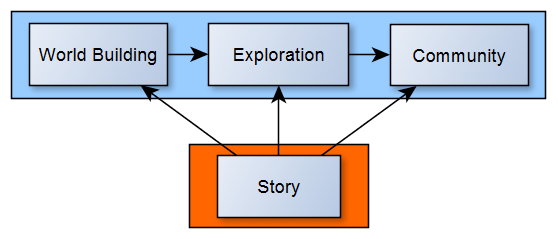
Cogmind Story Integration Diagram
The value of story elements in a roguelike, an overview.Theme and setting define a roguelike's starting point when it comes to source material, but crafting a story on top of it all (ideally with multiple plot lines) takes it to the next level. A story requires that actors have motives and goals, and the whole world feels much more alive when for the purposes of storytelling actors have goals other than "approach and kill player." Certainly mechanics and basic content like actor/object descriptions can go a long way towards reflecting the nature and state of the world, but a full-on plot reinforces it all in the strongest way possible: through action.
Seeing the game's lore in action really brings it to life, giving it added meaning beyond the words. From the beginning this approach has been important for Cogmind in particular because it strengthens the immersion, a focus of the whole player experience I've been going for. And on the development side that same desire to bring everything to life drives development to dig deeper. As the game world expands I've often asked myself "wouldn't it be neat if the player could actually visit that place? Or meet so-and-so?" And then suddenly there they are, being written into the game :D. As a result the world has gotten increasingly dense over time, with each new piece reinforcing one or more others.
Roguelikes infused with story elements also gain additional layers of meaning on top of whatever might happen in the world, contributing to a more "epic feel"--the world is definitely bigger than the player character, who can have a greater purpose beyond being a "murderhobo." With the 7DRL version a short back story merely provided the premise, good enough for a straightforward dungeon crawl, while I can't imagine the Cogmind of today without its deep and engaging story. Whole new maps and interactive NPCs were added to allow the player to influence the world in different ways, because it made sense in the context of the greater narrative.
Interactive stories also offer a good source of memorable crafted experiences, which can be even more complex and powerful than standard roguelike encounters because a story is capable of spanning multiple locations and events. For example, in Cogmind the player can visit a certain area where all hell breaks loose, which in turn affects other areas after that, the details of which could depend on other player actions. The story links different locations and actors in numerous ways, supporting a grander scale that few roguelikes attempt to tackle. (Lots of room to innovate here!)
While exploring the resulting web of possibilities, individual steps along the way provide the player with explicit intermediate goals. This means a greater number of "things for the player to do," generally a nice quality to have in a roguelike wherever it makes sense. These can be rewarding experiences in themselves, experiences that extend beyond simply killing things...
But it's worth noting that depending on its execution (covered in Part 3), the presence of a story does not have to completely supplant a player's own narratives, either. I've noticed players coming up with their own little stories all the same, just as they do in other roguelikes, based on the danger, unexpected RNG shenanigans, close saves, and deaths that come out of isolated encounters which may have no bearing on the wider plot. This is important because it's a valuable part of the roguelike experience, and demonstrates that it's possible to include a story without drowning out the emergent mini-stories made possible by procedural generation.
So aside from moment-to-moment survival and long-term progression strategy, story becomes a third potential target for player enthusiasm and purpose. This advantage works on both an individual and community level...
Exploration is a fundamental part of roguelikes, be it of mechanics, new content, or simply unrevealed procedural map areas. Having a story gives players yet more reason to care about (or justify) events in the game world, along with hooks which in turn drive exploration to find answers and/or uncover secrets. Not that the extra incentive is required for the game to be enjoyable, but it's nice to have one more channel through which players may connect with the world.
This feature also works on a wider level, from two people playing alongside one another to the community at large. Story elements become common points of reference, allowing players of an otherwise single-player game to share experiences in the same way they can talk about mechanics and strategy. Lore, locations, NPCs, motives, factions and more all become part of the "common language" that players internalize as they explore the world and what is happening in it. For anyone following along with the latest release, or who isn't spoiling themselves with the wiki, there's plenty of speculation to go around. From my perspective, it's been fun to watch the community puzzling out what's going on :D
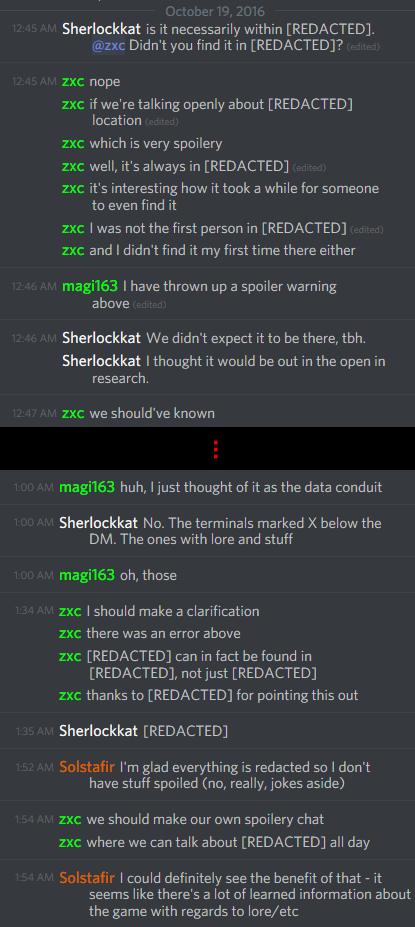
Cogmind Discussion (secret plot spoilers)
Players talking about secret plot spoilers in public chat :)Other aspects that contribute to the overall discussion and level of interest, both with regard to those outside the community looking in, and within the community itself:
All the minor actors and events that players talk about, some of them quite memorable like "the annoying derelict" as everyone has come to know a certain NPC with no particular name.
Story also adds another dimension to seeded runs, where different players may take the same or different approaches to the same set of story-related encounters.
Relatively rare events are especially meaningful, including those which rely on a chain of actions. There are a good number of comments along the lines of "I saw...!" and "Have you ever seen?!" Just last week a major plot event added to the game ten months ago was discovered by a player for the first time :P
In all it appears there's a lot of value in building a roguelike around a good story, assuming it's done right, but we'll get to that below.
Having identified several areas where I believe roguelikes can benefit from the inclusion of story elements, then comes the hard part: actually doing it :)
Because there are certainly a number of ways story can worsen a roguelike experience, the next step is to identify the characteristics of a good roguelike narrative, to show that permadeath and a procedurally generated world don't have to be completely incompatible with a rich story.
Of course, at the foundation here is the need to have a compelling story in the first place! That's kind of the whole point--if it's going to be a boring, generic story, then the game may as well get by on the merits of roguelike gameplay alone. Having that strong focus is good, but it would be really nice to tap into some of that value mentioned before. What type of story can achieve those goals?
As in all things game design, consistency is key. A story that makes sense due to its consistent internal logic reinforces the whole world building aspect (Part 1). With only partial familiarity, an observant player begins to intuit things, like where to find some object or actor, what impact a particular course of action may have, etc. by filling gaps in their knowledge with what seems reasonable. They may not always be right, but at least that path is available, and it's an enjoyable process for some. Plus being wrong is fun, too. Because surprises :)
So the most useful story in this regard will be one which makes heavy use of cross-references between the game's different forms of content and NPC dialogue, attitudes, behavior, everything... to strengthen player intuition and general understanding. Just like solid mechanics anchor the gameplay, so can a solid story anchor the content.
Cross-referencing also makes it easier to avoid one of the bigger pitfalls that can detract from the value of story: linearity. Unless it's somehow part of an intentional underlying theme for the game, a linear story is almost certainly bad for a roguelike. It works against the freshness of each playthrough intended by the use of procedural generation (not to mention the annoyance of having to repeatedly face the exact same story content on each death!). Instead, make sure the story is easily split up into smaller chunks that can just as well be experienced independently of one another and still be interesting and meaningful (more on that below).
A complex plot with multiple interconnected threads will also naturally be a lot more replayable.

Cogmind Major NPC Visualization
Abstract visualization of Cogmind's potential plot-related encounters with major NPCs, colored by faction. The beginning of the game is at the left, and it progresses to completion at the far side. Many of these encounters have implications for later encounters, for the player, or for the world in general.Notice that the story plays a lesser role in the early game, which as the most commonly replayed segment could grate on the player if there were too heavy an emphasis on static elements. This especially makes sense for Cogmind because there is no initial character generation phase, though other games could even attempt to use the very beginning to introduce a wider array of story-related options.
Story encounters shouldn't simply be meaningful in a lore sense, but have real implications for the rest of the game, basically giving the player's actions consequences on a higher level. Most roguelikes have a relatively short feedback loop--fight a battle, rest up, maybe raise a level, then explore until the next battle. Story elements large and small can be integrated into the gameplay itself, adding a unique kind of replay value by being elements the player can choose to engage with as part of a long-term strategy. Depending on what the player decides to do, the plot might affect later events in a significant way, have no impact at all, something in between, or maybe just cause some immediate effect. As the player becomes aware of static elements within the plot, on future runs they may or may not want to trigger certain events depending on their plans, condition, and where they happen to be.
So the story is not there simply for story's sake, serving as the basis for additional long-term feedback loops. For this reason I try to ensure many aspects of Cogmind's story have useful (or at least interesting) consequences for the player. This extra dimension to the world creates gameplay deeper than the average pure dungeon crawler, and despite the static elements the approach has proven resilient in the face of many replays. Plus there's always room to expand the number of options! Even a modest number of interactive elements can lead to a large variety of combinations and outcomes.
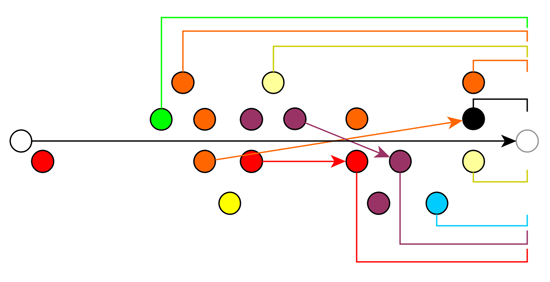
Cogmind Major NPC Visualization (w/long-term impact)
The same major NPC encounter visualization from earlier, showing those with a direct effect on some later encounter (arrows), as well as those with a relatively significant long-term impact on gameplay (bracketed length).Despite everything said so far in this series, one of the most important characteristics of Cogmind's story is that it is completely optional.
The game should be enjoyable without requiring that the player make sense of the story to progress, or pay any attention to it at all. Players new to the game can go from beginning to end on no more than the idea that "okay, I'm a robot and there are robots out to kill me... dakka dakka boom." In fact, every single dot in the diagrams above can be avoided or ignored.
Not shoving the story in the player's face helps decrease the tension between those static elements and the procedural world, giving the latter plenty of room to breath. Many people enjoy roguelikes purely for the gameplay, or prefer to do their own procedural storytelling, and there's no need to take that space away. One of Cogmind's best players played for over a year without interacting with the story, though more recently said he gained a new appreciation for the game after beginning to dig deeper.
At the same time there are other players who from the outset put the most effort into uncovering every bit of the story, lore, and secrets they could find. For the vast majority of the lore and story elements, the player has to actually be curious enough to seek them out, and keeping it optional accommodates two very different types of players.
From a content perspective, technically Cogmind's narrative is not centered on the player, making it much easier to be optional. This is probably an important factor when developing a rogeulike with story, as it doesn't need to be annoyingly pervasive if the player holds some lesser role.
Another important characteristic is that the player is spoken to but never says anything in return (no obvious dialogue choices, either). Conversations are short one-way affairs, outside of which the player can simply express their intent through actions and by where they travel. Design-wise this can be a rather limiting factor, but besides keeping the experience streamlined (and easily ignorable!), design restrictions tend to lead to more creative solutions, so I've enjoyed working with it.
To recap, in my case the ideal roguelike story presents a compelling, consistent narrative linking much of the content, one that has a meaningful impact on the gameplay, but interacting with it is still an optional way to enjoy the game. Other roguelikes with different goals could certainly take an alternative approach to story elements, or leave them out entirely, but I aim to create a deeper experience than "just another dungeon dive," both in gameplay terms and with regard to telling interesting and meaningful stories. I believe Cogmind has succeeded at that so far, but there's still more work to do!
With Parts 1 and 2 as a background, it's time to examine the variety of methods Cogmind uses to achieve those goals, which are important considerations every step of the way. This is also what is meant by "weaving," because there are quite a few individual components working together to reinforce the narrative, and reflect it.
When creating a roguelike in which a story can thrive, I believe the most fundamentally important decisions involve the world layout and how the player traverses it. For a non-linear story experience, it makes sense to have multiple available destinations at once, be it presented as some kind of open world, or maps connected in some sort of network. Cogmind uses the latter, dividing the world into areas which belong to either the central complex, or branches linked from there but which eventually lead back to the complex. (I talked about this and several related topics in the World of Robots post last year.)
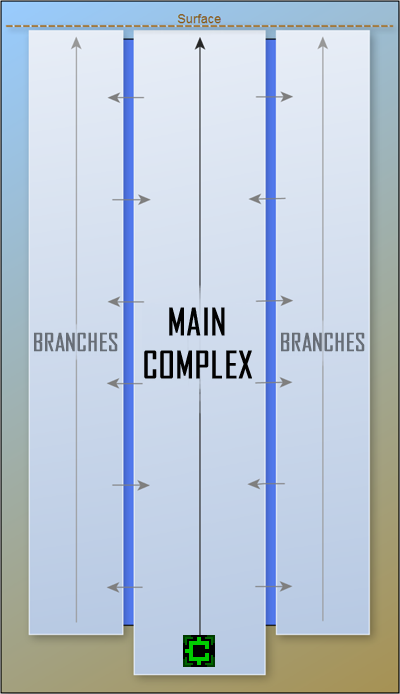
Cogmind World Composition Breakdown (simple)
A simplified breakdown of Cogmind's world.An important distinction between the two types of areas is that the story is confined to the branches, meaning the player can spend the majority of their time on the direct route to the surface/end and never even come in contact with story. There are no NPCs or dialogue along that route, and before long anyone who wants story will know where to find it.
Branches are structured such that the more story-oriented ones are generally deeper, and there is a quicker way to loop back into the main complex before seeing much, if again the player is not interested (or too weak, since story areas are more challenging!). Overall this structure is key to the "optional" characteristic discussed last time--players aren't required to engage with the story,
Most players do at some point start to develop an interest in the story, but it happens gradually, which is beneficial as it keeps the world simpler for new players, while opening up new options for more experienced players. In fact, for better players who may still be unaware of the story, the additional strategic options that stem from integrating story elements with gameplay are one of the primary hooks driving them to explore. For example there are the "manual hacking codes" which often link otherwise unrelated areas by having a code obtained in one area provide some kind of benefits in another.
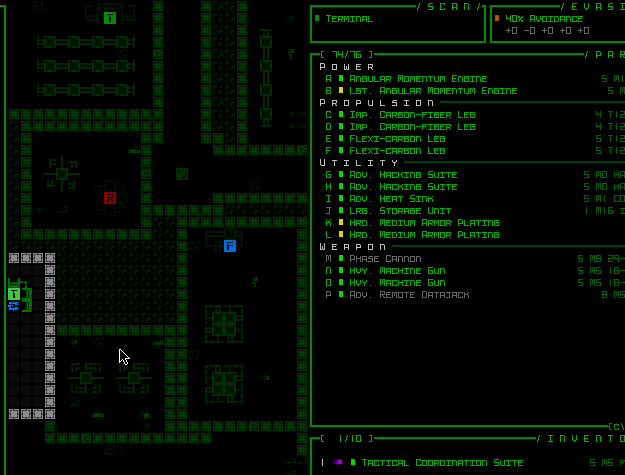
Cogmind Manual Hacking Code Assist (Machine)
Using the manual hacking code assist feature added in Alpha 10, listing where and who originally provided each code. (Also works for robot hacking.)That the player cannot backtrack to earlier areas is crucial here. Taking one route naturally closes off one or more others. Cogmind would be quite a different experience if it were open world, or even just possible to return to previous maps!
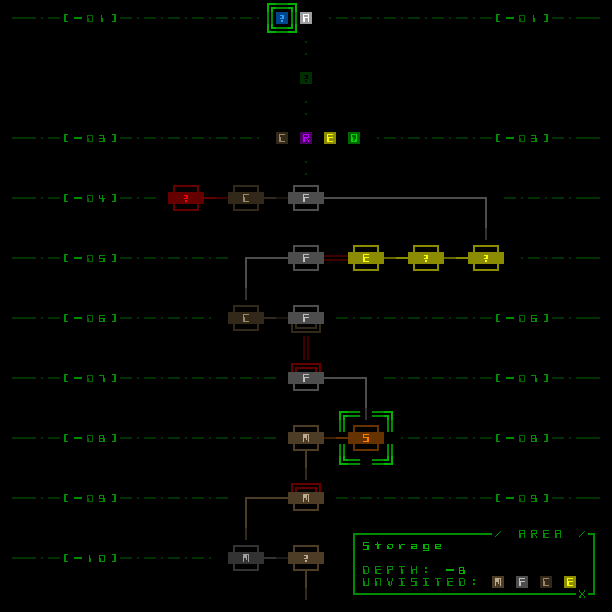
Cogmind World Map Sample Path
Sample in-game world map tracing the player's path from deep underground towards the surface.There is a huge amount of design freedom enabled by forcing the player forward, allowing for greater developer control which in turns makes it easier to maintain a more focused and fun experience. Good balance is important in a roguelike, but so is overall flow (not so much in sandbox roguelikes, where players are responsible for their own flow).
Note that all branches are accessible in every world, though the impossibility of visiting them all in a single run presents the player with interesting choices, choices that continue to expand as they learn more about its structure and get closer to the end.
There is quite a lot of lore in Cogmind, appearing in various forms to provide multiple different channels for the player to explore the story.
Games will naturally embed their lore, essentially the backbone of the story, wherever appropriate for the theme and setting. e.g. books, tombstones, travelogues, etc. At the extreme there are cRPGs which allow you to read inscriptions and text from just about any object, though traditional roguelike environments are only so rich and a systematic/streamlined approach is more appropriate, suggesting that we limit lore to a handful of easily recognizable sources.
One of Cogmind's primary gateways to lore are terminal records (definitely not an uncommon practice in sci-fi games :P). Terminals can be hacked for background information on various topics, organized so that the closer to the surface/end, the further into the story those topics are sourced. Most of the records are written from one of the factions' point of view, while records on terminals found in outlying areas might provide other points of view.
All pieces of lore are not created equal, either. Some are more mundane and generally available, while others are designed to be found in special areas, so uncovering the full set of lore and figuring out the story is somewhat of a puzzle that takes time--many runs (and a good enough player to piece together). The content of records may also link to other records, which can in turn be hacked directly from there, giving the lore a web-like form that always entices the player with yet more topics to explore :)
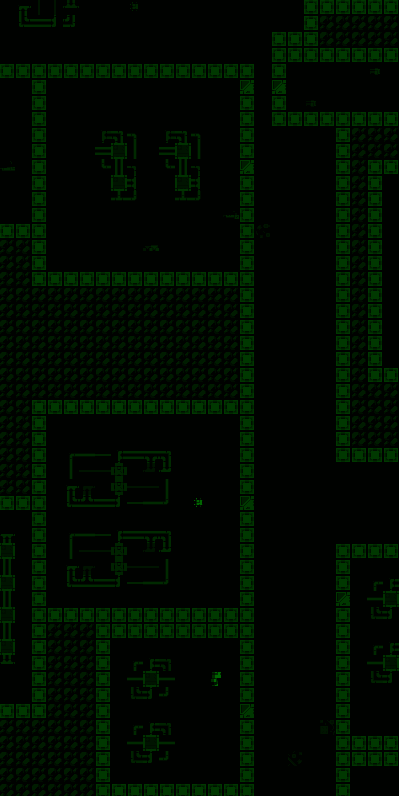
Cogmind Terminal Lore Hacking
Terminal record lore hacking, both via direct links and manually.If players don't want to hack the terminal records for whatever reason (and it's easy not to because terminals have so many other useful functions), then the story doesn't even come into play there.
Lore is also embedded in "robot analysis" records, which provide a real benefit to players who hack them (accuracy and dodge modifiers against that type of foe), but also describe their components and maybe a bit of story-relevant fluff about each robot's purpose or history.
Probably the lore feature most unexpectedly absent from Cogmind is item descriptions. Even many games without an emphasis on story (or any story at all) might have flavor text for item descriptions, using that to set the tone. In Cogmind this would be a massive amount of work--so many items!--and more importantly I don't think having that kind of fluff immediately available for items fits the theme. It wouldn't be able to do the best job an item description could do without muddying the idea that the player is a robot, and not actually playing a robot. There's also not enough room to display that kind of info without putting it in a separate window :P. (Note, however, that dozens of items do have lore in the form of terminal records, so it's not non-existent, just not ubiquitous.)
Lore can also be obtained by listening to NPCs, usually by bumping into them, but sometimes by simply coming into visual range. The content is often just fluff and tidbits from different viewpoints to reinforce the lore, as well as the occasional general tip or strategic or tactical suggestion. For those I try to write them in a way that feels like a logical thing the NPC might say (to a stranger or in whatever the given situation/location is), as opposed to an overt "I am NPC #23 and I exist solely to tell you this out-of-context piece of information."

Cogmind Dialogue Text Sample (msg log)
Sample dialogue text in the message log.As mentioned earlier all of these NPCs are off the beaten path to the end, but even there they and their dialogue are very unintrusive, simply appearing as text in the message log, and for a short duration at the bottom of the map view.
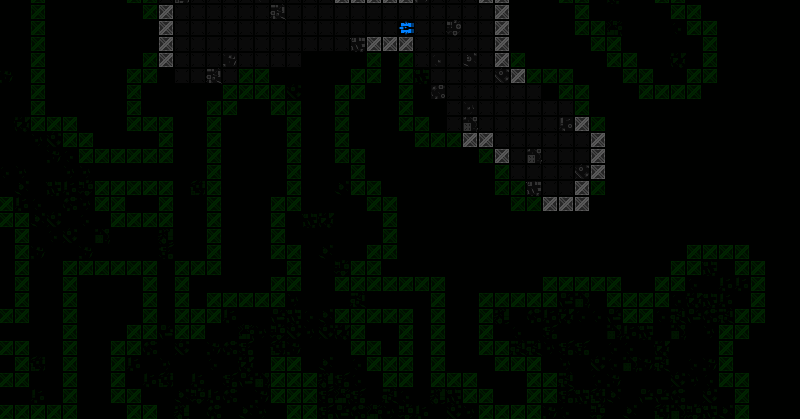
Cogmind Dialogue (on-map sample)
An NPC talking as the player moves around.Similarly, there are a few examples (it's an underused system...) whereby a short description of some scene may also pop up at the edge like that.
Slightly more intrusive are the modal dialogue boxes used for major NPCs and encounters in some special areas, though the frequency of those is kept to a minimum. It's quick and easy for the player to simply hit Escape or close the window for those they're already familiar with (or not initiate them in the first place).
See this earlier post for more talk about the dialogue UI.
Now that most of the lore is completed and in game, not too long ago a new and valuable feature was added: the lore collection interface. This is a central repository for all the lore the player has encountered throughout all of their runs, where "lore" includes most NPC conversations and terminal records. The contents are categorized by location and ordered alphabetically, where players can skip to a section by simply pressing the first letter of the entry they're looking for, or scroll around the list to autoload text.
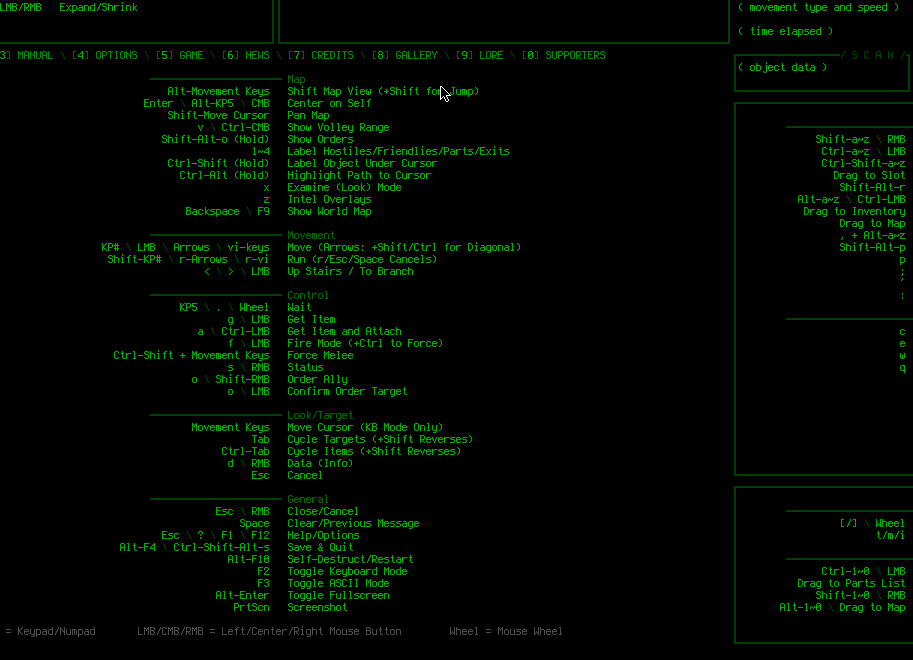
Cogmind Lore Collection UI
Interacting with the lore collection UI (here filled with junk because spoilers :P).To facilitate lore collection, terminal records the player has never read before are marked with a '!' directly in the terminals from where they are available. And beyond the reference value of having all this info conveniently in one place, the percent bar there at the bottom reveals some of the system's other benefits.
Players can know just how much of the information about the world they have or haven't discovered, which tends to encourage them to learn more about the world, a strong incentive to explore when combined with the (correct) assumption that these unexplored areas likely also contain lots of interesting gameplay possibilities!
Players are now comparing each others' "percentage of lore collected" (a bit of competition), and more importantly can watch their own meta progress in the new scorehistory.txt which also records the cumulative lore value at the end of each new run. It's nice to have progress meters aside from score alone.
Another aspect of Cogmind that fills out the world with story-related content, albeit in a piecemeal fashion rather than any kind of linear narrative experience, is the encounter system. These "mini-experiences" created with scripts and handcrafted map pieces, sometimes with heavy randomization, again reinforce the lore at various points.
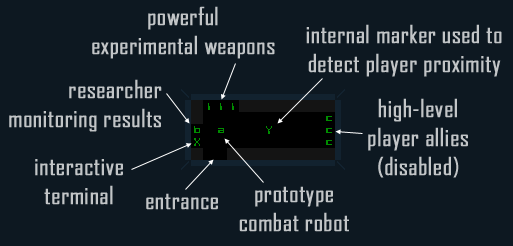
Cogmind Annotated Encounter Layout (Testing Firing Range)
An example prefab encounter as seen in REXPaint, the program I use to "draw" most of Cogmind's encounters. One faction is testing the effectiveness of their prototype robot and new weaponry, and what better target than a couple of their sworn enemies? (disabled, of course) There are a variety of things that can happen with this single scenario. A quick-thinking (and moving!) player could blast through the southeastern wall, which is likely along a corridor, and rewire the allies through the new entrance to immediately fight back. Or if the player is spotted and reported not far from this room, regardless of the state of the tests, said prototype robot will likely be dispatched in defense. Or the player may want to attack first and later rescue the allies, or do it to loot the room of its experimental weapons. Or ignore the room completely and stay out of trouble :POf course some of these experiences are pure fluff, though many have other implications as well. And while handcrafted, when placed near one another, or when players encounter them in various unique situations, emergent results make them somewhat unique each time. That's the beauty of mixing handcrafted content into procedural generation algorithms--it's possible to get the best of both worlds :D
I've written more about encounters before in articles on Map Composition and Generating and Populating Caves, though I haven't shown a distribution sample for any corridor-based maps before, so here's a new image:
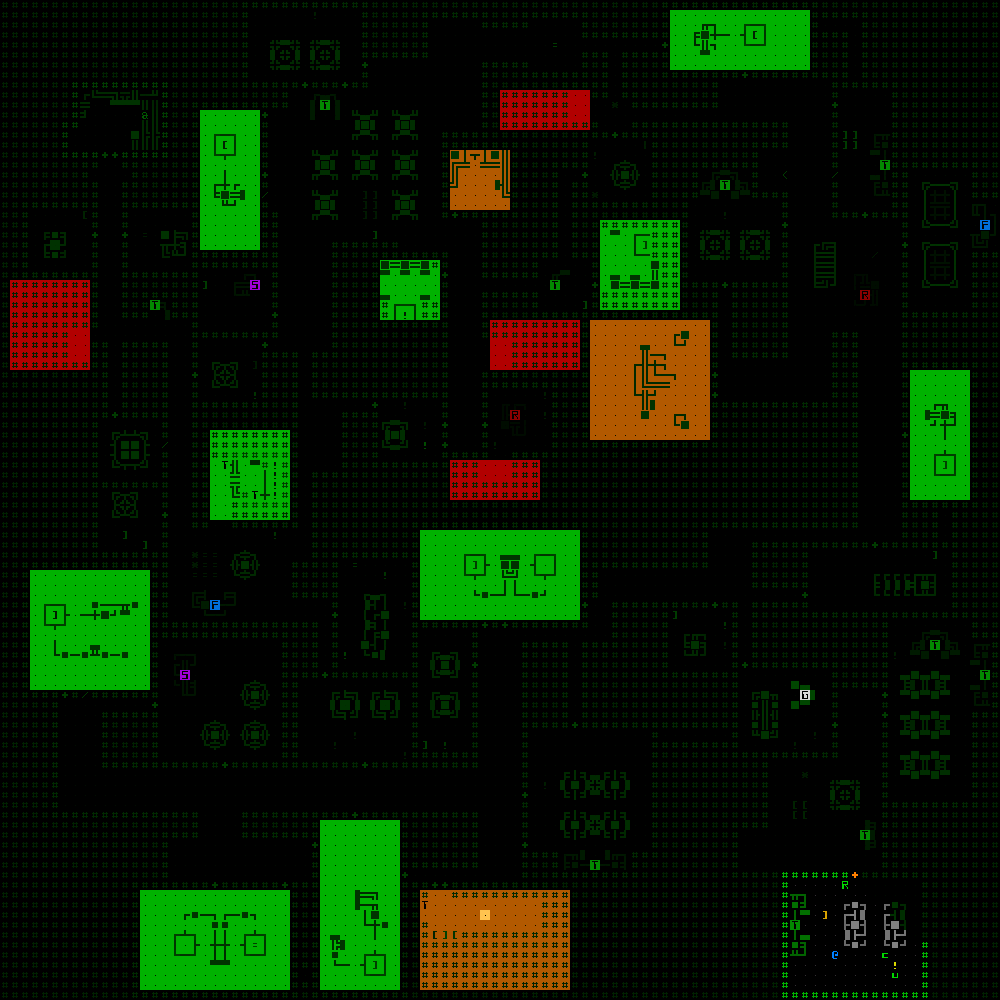
Cogmind Encounter Distribution Sample (tunnelled map)
Procedurally distributed encounters, colored by type.Localized environmental storytelling is easy to do like this. For example some scrap and broken down robots from two opposing factions strewn across a cave, or an abandoned partially-destroyed base that might still contain a terminal with bits of info as to what happened. This isn't commonly done in many roguelikes due to the traditional de-emphasis of terrain and props.
There are still other features that work to increase the appeal of story in roguelikes, though these don't constitute entire systems on their own so I'll cover them together here at the end.
Once a game includes NPCs, it's helpful to include a town of sorts, lore permitting. Cogmind has something like this located in an out-of-the-way area, and it's a great dumping ground for a lot of those tidbits of lore and knowledge mentioned earlier. Even better, the available dialogue for each run is selected from a larger pool, increasing replayability for a time. I've also seen a number of players appreciate the change of pace that such a location brings. Suddenly there's no fighting, no fleeing, just walking around enjoying the scenery and talking.
Secrets! Some topic mentioned in passing in one area might have some implication for another area. Or talking to one NPC might trigger some event elsewhere (or a chain of events!). Secrets drive exploration, and lore is a great place to sneak them in rather than in a purely environmental sense (e.g. "what's behind that door?" or "what if I attack this non-hostile actor...").
Multiple endings. Cogmind will have more than one ending, some of which reflect the extra difficulty of different approaches to the story elements, while others are simply different due to choices made. Unique endings reward the player for exploring alternative challenges, and are also an opportunity to tell a little more of the story, too. (Note: Cogmind does not yet include multiple endings--we're coming up on that soon, though currently a win is already rewarded with a somewhat different ending screen.)
This whole approach to telling a story with a roguelike boils down to the game being "story-backed" rather than necessarily "story-driven." Revealing the story piecemeal through many different means, where the most interesting parts are the hardest to reach, is a good design to follow since it provides incremental incentives and is more rewarding in the long run. It's actually easier to win a run of Cogmind than it is to discover the full story, making the latter a potentially even more rewarding experience for some players!
Either way, don't simply dump the story on the player--that's the boring method which gets repetitive fast. There are plenty of other options :)
Read more about:
Featured BlogsYou May Also Like